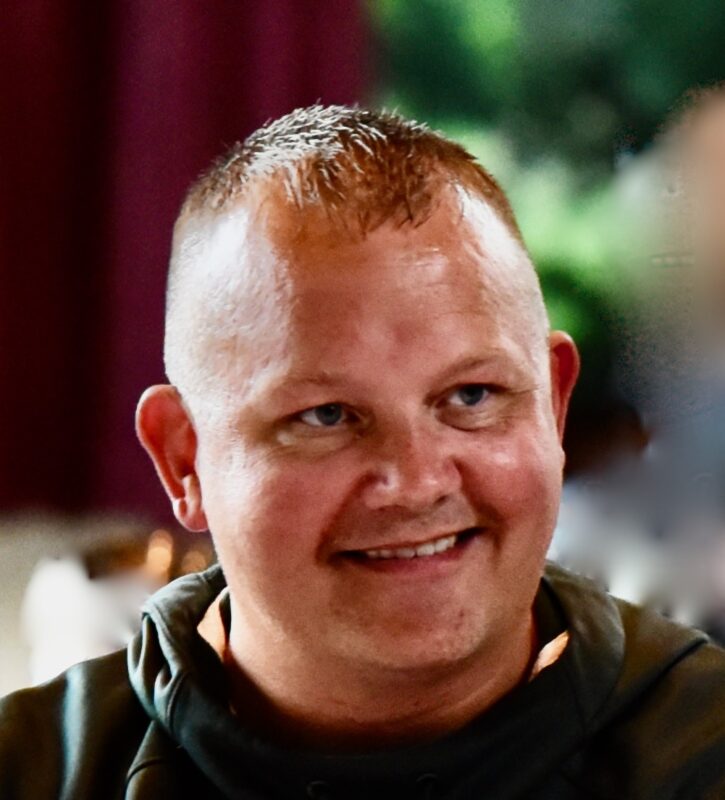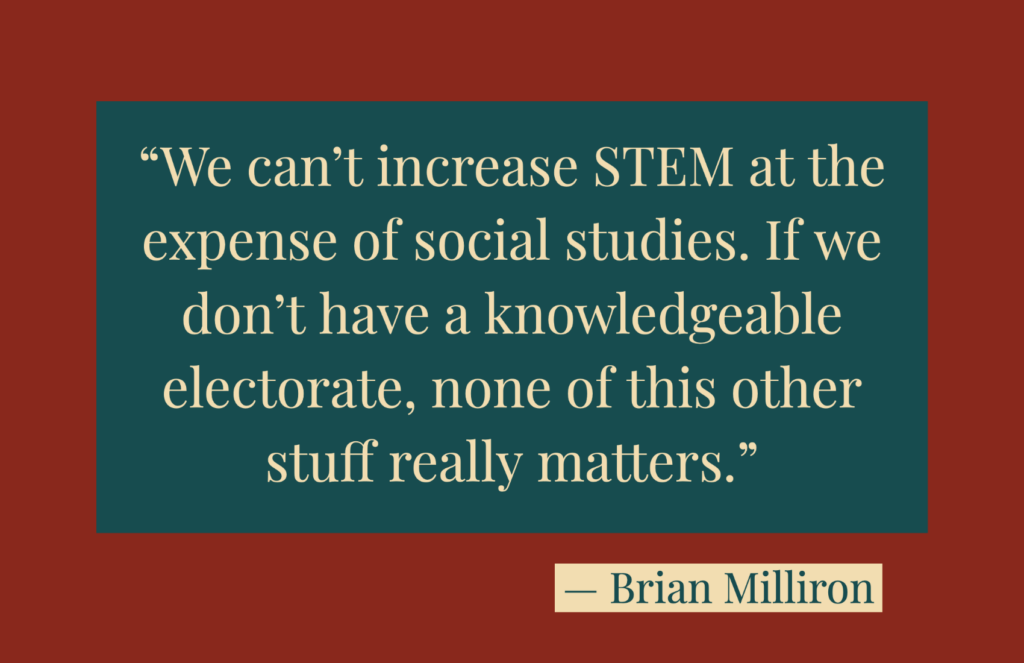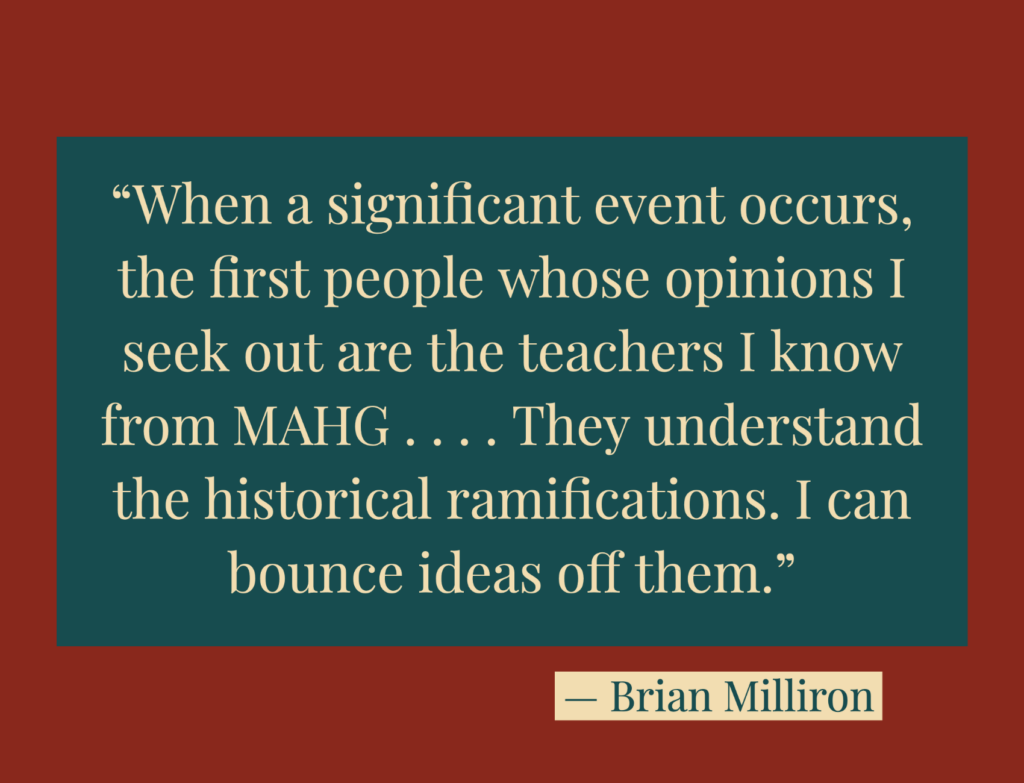Meet Our Teachers
Brian Milliron

Brian Milliron is a self-professed history and political science “nerd.” Awarded a Madison Fellowship in 2018, he took the advice of other fellows to enroll in the Master of Arts in American History and Government (MAHG) program. He felt immediately at home among the other teachers in the program, who love talking history and government as much as he does. “I loved going to the summer residential program, meeting people like me, sharing meals and even going out for a beer with them. It’s a unique community.” Yet Milliron voices a conviction all MAHG students share: that conversations about American history and government should not be the exclusive domain of nerds. Everyone needs such conversations.

Today, lack of basic knowledge about “how our government is structured, where it came from historically, and why it does what it does” prevents easy conversation about current events, Milliron says. “This is due to schools putting so much emphasis on STEM—education in science, technology, engineering and mathematics. If you increase STEM education, something else has to give, and social studies has lost out consistently.” Policymakers privilege STEM to prepare students for the global economy, “and that’s extremely important,” Milliron says. “But we can’t increase STEM at the expense of social studies. If we don’t have a knowledgeable electorate, none of this other stuff really matters.”
Milliron presses this argument as he serves his third term representing Western Michigan on the Michigan Council of Social Studies. Meanwhile, he teaches to fill the knowledge gap, enjoying every minute. “They’ll have to pull me out of here,” he says from his classroom at Whitehall High School in Michigan. “Every day—every hour—is different. Each class of 25 or 30 kids brings a new energy, born of the things that happened to them during the previous 24 hours. That’s what keeps me going throughout the day.”
Teaching at a Great School
He appreciates his school, which is well-resourced. The town of Whitehall sits on the shore of a small lake that feeds into Lake Michigan. Tourism and other local industries have preserved Whitehall’s middle-class tax base, and parents have time to support their children’s education. With 650 students, the high school is small enough for Milliron to know the students, yet large enough to support AP classes and extracurriculars. Milliron coaches not only the JV basketball and softball teams but also a “Quiz Bowl,” in which student teams from area schools compete to sound a buzzer and answer questions on a range of subjects. “It’s great for kids who aren’t athletes but want to exercise their intellects.”
The school also offers electives. In addition to four sections of senior-level government and economics, and one of AP US history, Milliron teaches a “Current Topics” class focusing on news that matters to students. “I start the semester off with stories on a range of current topics, to gauge their interest level in each, then ask if there is another subject they want to cover. Students this fall are interested in stem cell research. We’re going to look at the pros and cons of that,” along with other issues.
Even at a great school, students need the advocacy of teachers. This year the school district opted to open a week prior to Labor Day, and students with summer jobs serving lake visitors had to choose whether to quit them early. “Since COVID began, more students are working, many for too many hours. Some employers are ignoring rules governing the employment of minors. I placed phone calls and sent emails to certain businesses, saying, ‘you can’t do this to our kids!’ School is the most important thing,” Milliron insists.

When the pandemic began in March 2020, Milliron’s economics classes moved to the auditorium and doubled in size. This allowed widely spaced student seating while freeing another government teacher to shift into the role of assistant principal. Milliron had twice as many papers to grade and emails to answer. “Plus, being in an auditorium makes conversation difficult. They’re down there, I’m up on the stage.” in normal years, Milliron fosters lively debates that help students think through the looming responsibilities of adulthood. “This is a group of seniors, who are soon going to college and about to vote for the first time.”
He kept the class interesting by inviting guest speakers—candidates for political offices from each party, who fielded student questions. “Thankfully, in the fall, I had a student teacher for a couple of hours each day. In the second semester, when she had finished her credentialing program, our school hired her. That did not change my numbers, but it did help relieve the load of some other teachers.”
First, Build Trust—Then Engage the Content

Teachers need more than small class sizes to foster good discussions. They need students’ trust. “Few students enter the classroom caring deeply about US history and government. Before they engage, they need to feel that I see them as individuals and want to teach what‘s best for each of them. We do a lot of team-building the first week of the year. After that we get to the content.”
Engaging the content involves reading primary documents closely. First, Milliron must situate documents in their historical context. Again, this requires trust: students must feel Milliron knows what he’s talking about. Having studied history and political science as an undergraduate, then earned an M.ED in curriculum and instruction that entailed additional courses in world history, Milliron already commanded respect. But he saw students grow more engaged after he began MAHG work. “Few college surveys of American history cover more than the big events: the American Revolution, Civil War, the World Wars. They merely gloss over the Progressive Era. In MAHG I read documents from Woodrow Wilson, Teddy Roosevelt and others. I learned about sources I could excerpt for my students the next day. I could explain their historical context because I’d read the entire document.
History and Government Go Together
“MAHG does a great job of putting the historical and political together. Stories I learned in MAHG work in both APUSH and government class.” For example, students understand the logic of our Constitution better if they know about the Articles of Confederation that preceded it, and why those articles proved inadequate.

He continues to learn through the network of friends he built in MAHG and through the Madison program. “When a significant event occurs, the first people whose opinions I seek out are the teachers I know from MAHG and from Georgetown. They’re following events closely. They understand the historical ramifications. I can bounce ideas off them. I don’t know any teacher who found the 2020 election cycle reassuring. But I was glad I could talk with people who could compare it to other contentious elections.” Last summer, Milliron took Professor John Moser’s class on the 1968 election, reading documents from the 1968 Democratic Party Convention and playing a “Reacting to the Past” game in which each teacher represented one of the clashing constituents at the convention. “It was fantastic,” Milliron said; it will help him during elections of the future, given that political polarization shows little sign of diminishing.
Civil Debate Is Healthy
Milliron tries to model healthy, good-natured disagreement. As his students begin to open up about their own views, he challenges them. “No matter what side of an argument you guys take, I will take the opposite side, even if it’s not my real opinion. If you go to the far right, I’ll go to the far left, and vice versa. Get ready to defend yourselves, to push back against me.” Students start to understand that political disagreement can be healthy. Hearing Milliron spell out the logic of political positions they have never before considered may help them find ways to compromise.
Without the experience of safe and fruitful debate, how will Americans recover the common ground they need to share in self-government? “It has to come through education,” Milliron says.
